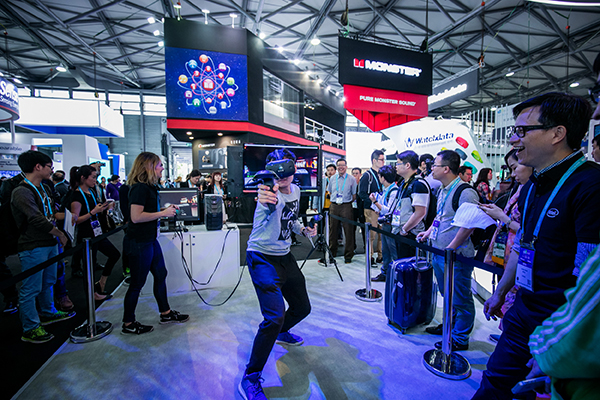 |
|
A man tries out a virtual reality headset at the 2016 CES Asia in Shanghai. There were more than 200exhibitors at this year's show. [Photo provided to China Daily]
|
In 2015, 14 million new entities were registered, representing a 14 percent year-on-yeargrowth. Meanwhile, some 558,000 university graduates and college students had started theirown businesses, a 16.9 percent year-on-year increase.
Angel funds in China had also surged significantly, according to the NDRC report. In 2015,the combined angel funds in China reached 20.36 billion yuan, three-fold the amount in 2014.By the end of 2015, China was home to about 3,000 venture capital funds and angel fundswhich had a combined capital of more than 1 trillion yuan.
"A pro-entrepreneurship policy environment, the rising numbers of funding opportunities andthe allocation of more social resources to encourage innovation are in line with the country'saspirations to transform its economic growth patterns and upgrade its manufacturing andindustrial sectors," said Sun Weimin, chief of the information department at the Ministry ofIndustry and Information Technology. Sun is also in charge of an annual contest formanufacturers hosted by the ministry.
Sun noted that another major factor behind the growth of China's innovation sector is thesupport provided to manufacturers and entrepreneurs by local governments and enterprises.For instance, several funds have been set up to support the innovation drive andcomprehensive networks have been established to help startups locate investors andincubators. There are more than 20 incubators and industrial zones in Shanghai that cover awide range of sectors, including robotics, navigation and healthcare.
"We have held two contests for manufacturers in the past two years and some of the award-winning projects have been introduced to enterprises which can take advantage of theseinnovative technologies. For example, a three-dimensional shoe-making project has beenturned into a shoe-making enterprise and will be heading into mass-production, while anotherproject that utilizes robotics to handle logistic tasks has been popularized in the logisticssector," said Sun.
One of the new trends that manufacturers have noticed is the shift in interest toward productsthat are environmentally friendly. One such company at CES Asia that fits this mold isSheedo, which creates paper made from waste cotton. The unique thing about this product isthat it also has seeds embedded in it-people can plant it in the ground after usage instead ofdisposing it in a rubbish bin.
"China is now becoming more concerned about the environment and it's time for Sheedo togrow here in Shanghai. The business model is simple to understand-it is about turning rawmaterials into valuable and environmentally friendly products such as business cards, flyers,coasters, chopstick-holders and many other things that can be made using paper," said GloriaGubianas Blanes, the founder of the Barcelona-based company.
Another notable project at CES Asia this year was a body temperature monitor that looks likea band-aid. Developed by a Changzhou-based medical technology enterprise, the device ispowered by paper battery technology and can monitor a person's temperature for up to 48hours.
"It may be a small gadget but there is great demand for such devices. In China alone, morethan 800 million thermometers are produced annually," said Xie Rui, the marketing specialistof the project.
Industry experts said that they expect to see more manufacturers working in teams andleveraging each other's expertise as the competition heats up in the innovation scene. XiaJunfeng, project manager with startup incubator Nanjing Maker Space, said thatmanufacturers need to work with other parties if they want their products to reach thecommercialization stage as quickly as possible.
"It is unlikely for one individual to handle all the tasks involved, such as product design,marketing, intellectual property rights protection and fundraising, so manufacturers will needto work in teams to be more efficient and effective," said Xia.
"The days of being able to present an idea and secure easy funding are gone. Investors todayare very savvy and they demand easy-to-understand business models as well as gooddesigns. Very often, makers will also need to take advantage of social media to extend thereach of their projects."
